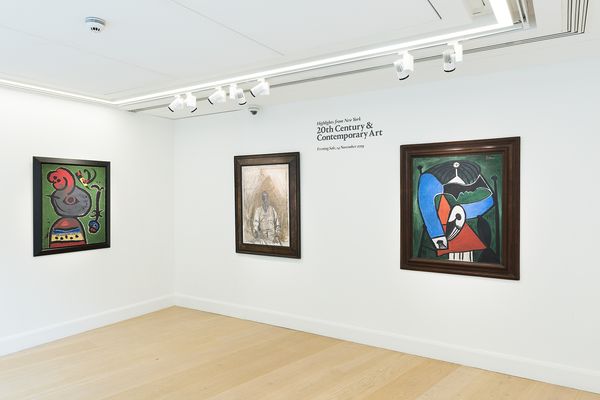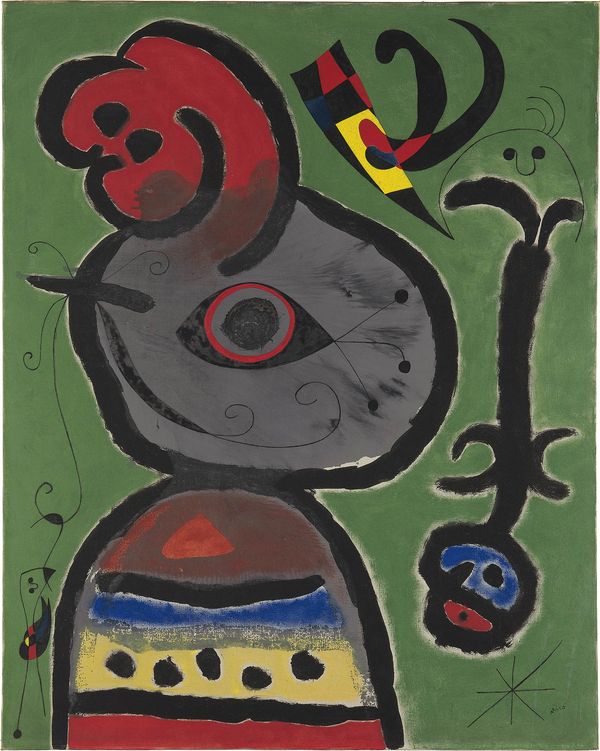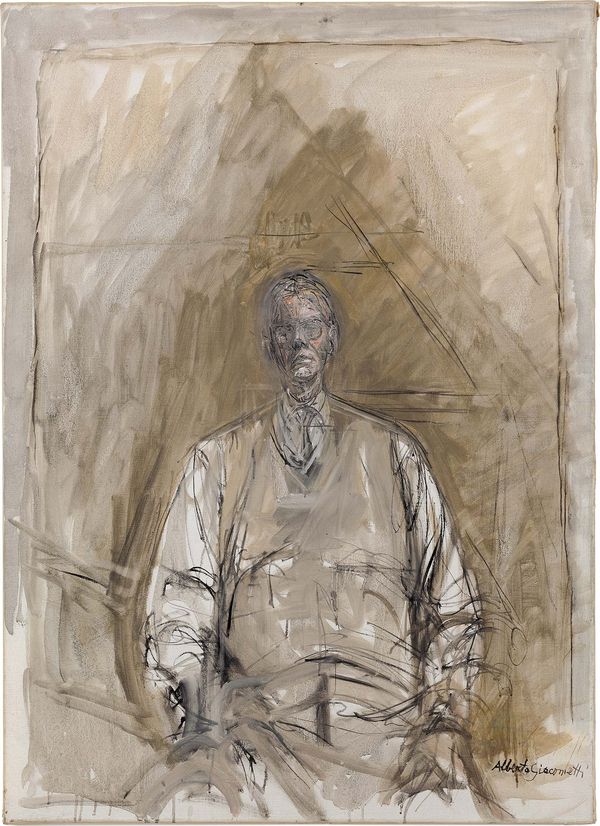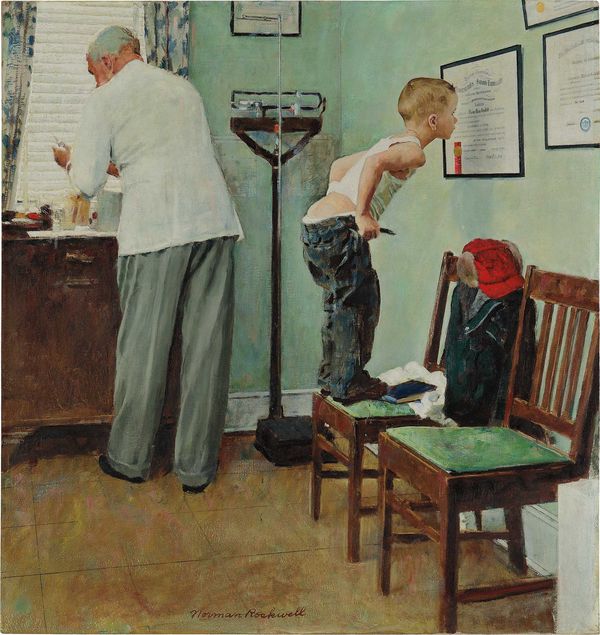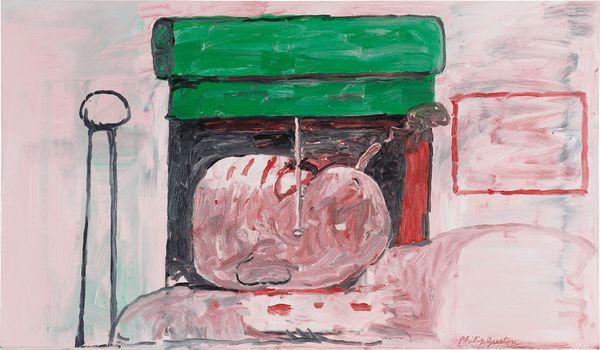Highlights from our New York 20th Century & Contemporary Art Evening Sale on view in London.
By William Paton
Seldom in the history of art have so many cataclysms taken their toll as in the first half of the 20th century. In Europe and the United States, millennia-worth of cultural baggage was suddenly overthrown and the previously-accepted precepts of art were turned on their heads. After World War I, Dada and Surrealism sang of the chaos and brutality of existence while other artists celebrated the wonders of technology. In the wake of World War II, a more provocative embrace of the darkness and chaos seen to lurk in the heart of mankind emerged. On both sides of the Atlantic, when the rulebook was thrown out, abstraction filled the void. In Europe, Art Informel prevailed, while Abstract Expressionism flourished in the States. Despite this, a number of trailblazing artists determined to remain anchored to figuration, to the image.
Joan Miró Paysan catalan inquiet par le passage d'un vol d'oiseau, 1952. Estimate: $7,000,000-10,000,000.
20th Century & Contemporary Art Evening Sale at Phillips New York, 14 November.
Some had already been working in the previous decades. Joan Miró, for example, had developed his own unique and lyrical Surrealism in the wake of World War I. Responding to a changing world, Miró’s style continuously evolved, as demonstrated by Paysan catalan inquiet par le passage d'un vol d'oiseau of 1952. This energetic painting combines Miró’s long-standing themes and techniques with a fresh new directness and a forceful sense of gesture. Inspired in part by the ugly nature of the Spanish Civil War and World War II, this also owed a debt to the advances in American abstraction which had been inspired by his own example. Miró observed the American avant-garde with fascination, as the teacher retaining the enthusiasm of a keen student. This is reflected in particular in the expressionistic outlines that delineate the main figure, which are thrust into bolder relief through their contrast with other more meticulous, calligraphic areas.
Pablo Picasso Femme assise dans un fauteuil, 1948. Estimate: $5,000,000-7,000,000.
20th Century & Contemporary Art Evening Sale at Phillips New York, 14 November.
Similarly, Pablo Picasso’s Femme assise dans un fauteuil of 1948 continues the artist’s long history of probing the frontiers of figurative expression. Picasso’s Blue Period, after all, had been but the first of many one-man artistic revolutions, and had taken place almost half a century earlier, with Cubism following less than a decade later. Compared to Picasso’s recent images of an anguished Dora Maar, Femme assise dans un fauteuil is an image of tranquility, with sinuous curves defining much of the composition. Picasso also introduced elements of his own private lexicon—the profile in the arms, the small head of Françoise, the palette-like claw of a hand—to explore the expressive potential of his signs. At the same time, there is a darkness to this painting, with the tiny head shown isolated against its swathe of dark hair, revealing the artist tapping into the atmosphere of existential anxiety that characterized so much of the firmament of intellectual life at the time in France and in Europe.
Alberto Giacometti Portrait of David G. Thompson, 1957. Estimate: $5,000,000-7,000,000.
20th Century & Contemporary Art Evening Sale at Phillips New York, 14 November.
This characteristic is even more noticeable in the works of Alberto Giacometti. In his Portrait of G. David Thompson of 1957, Giacometti has presented the wealthy American visionary collector in a manner that echoes Picasso’s depiction of Françoise. He is swimming in the expanse of the canvas, and his scale introduces a poignant sense of fragility that is only accentuated by the dabbed accumulation of black and ochre brushstrokes that coalesce to give a spectral sense of his presence. In conveying Thompson in this flickering, tenuous manner, Giacometti has created not only a portrait but a searing existentialist vision of the fickle nature of life itself.
Henry Moore Family Group, 1947. Estimate: $2,500,000-3,500,000.
20th Century & Contemporary Art Evening Sale at Phillips New York, 14 November.
Compared to the works of the contemporaries mentioned above, angst and turmoil have less of a place in Henry Moore’s Family Group, executed in 1947, only a few years after the end of the War. Moore’s stylized figuration, with bodies shaped like pieces of flint or bone, leaves little room for gloom or cynicism in comparison to its existentially-tormented contemporaries, instead demonstrating Moore’s belief that “the war brought out and encouraged the humanist side in one’s work” (Henry Moore, quoted in Roger Berthoud, The Life of Henry Moore, London, 1987).
Norman Rockwell Before the Shot, 1958. Estimate: $2,500,000-4,500,000.
20th Century & Contemporary Art Evening Sale at Phillips New York, 14 November.
This humanism finds an analog in Norman Rockwell’s Before the Shot of 1958, a work of intense observation. During its creation, Rockwell is documented to have sought the correct flooring, the correct chairs, the correct position for the doctor, and even the correct amount of buttock being exposed in expectation of the titular shot. This is a magical vignette of American life. Rather than showing a world in which the center has come unstuck, as was often the case with Rockwell’s contemporaries on both sides of the Atlantic, this instead immerses us within the narrative of everyday existence. It is a celebration—albeit one with a sense of ominous anticipation as the moment of the jab approaches.
Philip Guston Smoking II, 1973. Estimate: $6,000,000-8,000,000.
20th Century & Contemporary Art Evening Sale at Phillips New York, 14 November.
There could not be a greater contrast between this approach to figuration and that of Rockwell’s compatriot Philip Guston. In the final phase of his career, beginning in the late 1960s, Guston turned away from the celebrated abstraction that he had helped to pioneer and instead began creating often unsettling images of various figures, oftentimes times depicted with bulbous heads. In Smoking II, dating from 1973—near the very beginning of this seminal development—Guston depicts a reclining self-portrait, cigarette dangling from the mouth as the murky night sky envelops the space behind the smoker's head. As Guston makes clear, Europeans did not hold a monopoly on anxiety.
